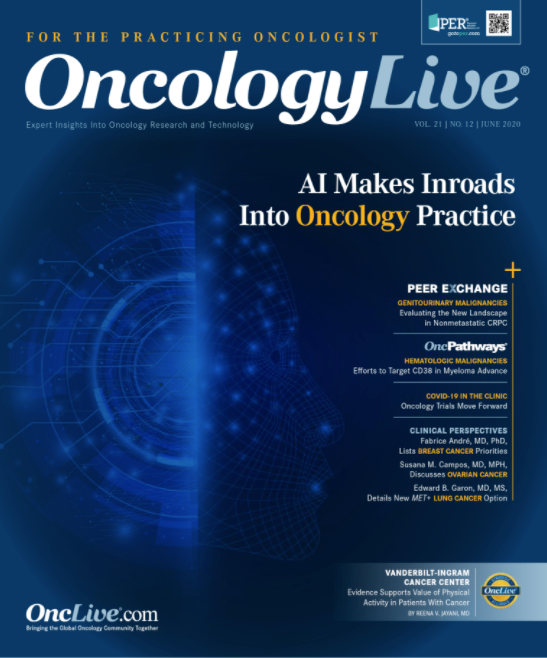AI Makes Inroads Into Oncology Practice
Oncology practices large and small are starting to tap into the power of data analytics and artificial intelligence to help identify patients at risk of relapse or adverse effects and to assist in making clinical decisions on care.
James Hamrick, MD

Oncology practices large and small are starting to tap into the power of data analytics and artificial intelligence (AI) to help identify patients at risk of relapse or adverse effects (AEs) and to assist in making clinical decisions on care. Informatic tools are now using predictive analytics and evidenced-based mechanisms, and these are being combined with electronic health records (EHRs) to bring the power of big data to daily practice.
Although the impact of these systems is just starting to be felt in the oncology field, tools that support routine clinical decisions and genomic risk stratification are likely to be adopted more broadly within the next several years.1 Experts say this is a trend that promises to dramatically change the way care is practiced and delivered.
Potential uses for AI systems that could affect decisions on cancer care for individual patients include predicting the risk of AEs from chemotherapy, the likely duration of response from chemotherapy, recurrence risk, and overall life expectancy.1 Systems that incorporate evidenced-based mechanisms or predictive analytics can also help deliver value-based care and reduce the risk of hospitalization due to AEs, proponents say.
The trend toward alternative payment models that are focused on value is going to help drive the adoption of these tools, James Hamrick, MD, senior medical director at Flatiron Health, an oncology technology and research company, said in an interview with OncLive®.
“There is some appetite to pay for [these tools] but I think practices and hospitals are appropriately conservative. These are sophisticated tools so they have to work and deliver value.”
Debra Patt, MD, PhD, MBA

The power of using big data goes beyond immediate clinical utility, said Debra Patt, MD, PhD, MBA, a breast cancer specialist who is executive vice president at Texas Oncology in Austin, part of the US Oncology Network. “When you have practice management systems integrated with electronic health records integrating with research platforms, you can get information that allows you to make better decisions about all aspects of care delivery.”
Data-driven algorithms that would be meaningful in clinical practice are part of a robust AI sector in health care. The market is valued at $5.9 billion this year and is forecast to grow to $31.3 billion in revenue by 2025, according to Grand View Research, an industry analytics company headquartered in San Francisco, California.2
In oncology, a range of applications are being developed. For example, COTA, a health care technology company based in Boston, Massachusetts, has created a tool that helps cancer centers correlate care patterns with outcomes. The system can help center directors understand patient populations and treatment patterns. Called Real-World Analytics (RWA), the program collects clinical data from EHRs and extracts outcomes from this information. It allows centers to view specific care delivery trends, such as progression- free surival and overall survival. COTA now is working to add cost data to the system.
C.K. Wang, MD

“It’s not unusual for centers to not fully understand what types of patients they see and the specific characeteristics of thosepatients,” said C.K. Wang, MD, chief medical officer of COTA. “As we move to a value-based reimbursement model, they need to understand how patients are being treated and with what drugs and the outcomes of those therapies.”
Examples of COTA’s research were on display at the 2020 Amercian Society of Clinical Oncology Virtual Annual Meeting, where the company presented 5 abstracts. The research included using real-word data to analyze trends in immunotherapy use for patients with non–small cell lung cancer and to report disparities in treatment patterns for African-American patients with multiple myeloma.3
Identifying At-Risk Patients
The term predictive analytics is defined as a branch of advanced analytics that uses “electronic algorithms that forecast future events in real time.”4 The foundation for expanded use of predictive analytics in health care has been established through the digitalization of medical records, the availability of data storage in the cloud, software advancements, and mobile technologies.5
In oncology, evidenced-based AI tools are starting to be used in 3 key areas: population health management, radiomics, and pathology.1 Patt said many tools can now model the outcomes of patient visits to the emergency department and hospitalizations but the challenge is how to make that information meaningful operationally. Other challenges involving data collection and analytical bias exist as well (Figure).1
Figure. Challenges Facing Predictive Analytics in Oncology1

Predictive analytics is expected to allow clinicians to understand up front the patients who are more likely to experience AEs. “As oncologists, we live in a reactive world,” Hamrick said. “The only time I have insight into what is going on with a patient is when they are in my office, or perhaps when I hear that they landed in the emergency room or hospital. For the patient, the journey is every day. They are dealing with the physical, financial, and emotional toxicity of their cancer. …If we can understand at the beginning of chemotherapy what are the factors that make it likely that this patient may wind up in the emergency [department], then we can shift resources and interventions so we can move from reactive to proactive.”
Technology companies and larger hospital systems are beginning to develop the tools that will allow these types of analyses. The task is Herculean, as research conducted by a team of Google and academic researchers shows.6
Their predictive modeling study used deidentified EHR data from patients hospitalized at 2 US medical centers for at least 24 hours and found nearly 47 billion data points—an average of more than 200,000 per person—for characteristics such as demographics, provider orders, diagnoses, procedures, medications, laboratory values, vital signs, and clinical notes.6
At Memorial Sloan Kettering Cancer Center (MSK), investigators developed a risk model that used its own EHR data to identify patients at high risk for a potentially preventable acute care visit.
Robert Daly, MD, MBA

“We wanted to identify those patients we thought would most benefit from intensive monitoring between clinic visits to be able to actively intervene for those patients and help mitigate their suffering and symptoms,” Robert Daly, MD, MBA, medical oncologist at MSK in New York, New York, said in an interview.
MSK conducted a pilot program from January 2014 to September 2018 using a model that was built internally using 270 observation-level features from electronic medical record data collected from the initial visit to the first antineoplastic order. Features were grouped into categories that included sociodemographic data, malignancy and treatment characteristics, laboratory results, medical and social history, medications, and prior MSK acute care encounters. The model helped to identify the patients who accounted for 35% of potentially preventable acute care visits and 51% of the inpatient beds used by the cohort.7
Isaac Wagner, senior director of strategy analytics at MSK, said the decision to create their own analytics tool was based on the fact that they were trying to address a specific problem: identify patients with toxicity to chemotherapy for an intensive monitoring program.
“I haven’t seen any product that solves this problem,” he said in an interview. “For us, some of the most useful data were from custom forms we created ourselves. A vendor is likely to use data that everyone has in their system in the same way and that could miss a lot of things. There is also the component of speed. We didn’t just want to use claims data. It had to be data that are available before the clinical decision.”
Moving forward, Daly said the center is looking at how to best incorporate the risk model into decision-making and scale the monitoring program. “The model predicts risk at an initial point in time before the patient starts the first treatment,” he said. “We heard from many physicians and nurses that they would like to see a more iterative risk model over the course of the patient’s treatment and then make a determination about when to intervene with intensive monitoring.”
Tapping Into the Data
Large data sets are needed to build a predictive model to enable the tools to be effective. As a result, smaller practices are seeking out the experience of AI companies to provide insights into their own patient population. One such company is Jvion, an analytics company based in Suwanee, Georgia. In oncology, the Jvion Machine uses clinical and nonclinical factors such as patient socioeconomic status and environment to analyze a patient’s risk for 7 vectors: 30-day mortality risk, 30-day readmission risk, 6-month deterioration risk, avoidable admission, patient experience and pain management, depression risk, and risk of not showing up for an appointment.8 Cardinal Health Specialty Solutions, a health care services and products company, worked with Jvion to develop the tool.9
The Center for Cancer and Blood Disorders (CCBD) in Fort Worth, Texas, has been working with Jvion for 2 years on a pilot program that began when the practice was implementing the Oncology Care Model (OCM) payment program, said Ray D. Page, DO, PhD, president and director of research at CCBD.
Ray D. Page, DO, PhD

“With OCM, it was essential that we identify our patients who were at highest risk of having adverse events,” Page said in an interview. “Therefore, once identified, we could triage these patients and case manage them closer to keep them healthier resulting in better outcomes.”
Page said CCBD is planning an analysis of the return it has received on its investment with the Jvion Machine. “We need to crunch our OCM performance numbers in a way that it can prove the financial advantages of this tool. We need to do that and publish it.”
Focusing on the Point of Care
The promise of big data is that it can provide more accurate answers about which treatment is most effective for a specific patient with certain characteristics and the likely short- and long-term risks and benefits of a given therapy.10
Specifically, advanced analytics can be used to provide actionable oncology data at the point of the care to enable decisions that are backed by guidelines and published evidence; however, most EHR systems do not have this information embedded into them.11
The American Society of Clinical Oncology (ASCO) is trying to address some of these issues with CancerLinQ, which collects and analyzes real-world cancer care data from cancer centers and oncology practices across the United States. CancerLinQ currently has more than 100 subscribers, and 60 practices have completed the onboarding process to establish a link between the CancerLinQ database and their EHR system.12
The promise of CancerLinQ is to be able to collate real-world patient data, including outcomes, so that assessments can be made about treatment for current patients, Barbara L. McAneny, MD, a medical oncologist/hematologist who is chief executive officer of New Mexico Cancer Center in Albuquerque, said in an interview.
Barbara L. McAneny, MD

“Clinical trials require that patients be triathletes with cancer, with no other conditions, no other previous cancers, promising to be completely compliant and sufficently affluent that they can afford to travel to a university setting to participate in a clinical trial,” said McAneny, who formerly served as president of the American Medical Association. “That is not the population we treat. We treat people who are human beings, with all their foibles. They are not always compliant, they lack resources, they skip appointments, they have diabetes and hypertension and heart problems and elevated creatinine—all the things that would exclude them from a clinical trial.”
McAneny said ASCO needs to address some issues that make it difficult to use CancerLinQ as a resource at the point of care. One concern is how physicians upload data. “If busy physicians struggling to keep up with their work have to enter data, it isn’t going to happen. If practices have to pay somebody to do data entry, it isn’t going to happen. ASCO has made great strides in this. But we aren’t entirely there.”
Additionally, she said, querying the database should be easier. “On a day when I am seeing 25 to 35 patients, I don’t have time to take an hour to query a database and sort through for an answer. I need to have simple questions answered, for example, how many people with this regimen also have these other problems. If I can do that, ideally with the patient in the room, then you have a tool that is really going to change how care is delivered.”
Robert S. Miller, MD, medical director at CancerLinQ, said via email that the organization is working to address such concerns. CancerLinQ is continually adding usable cases—information from more than 1.5 million patients with cancer as of the end of April—to the CancerLinQ database, up from 1.4 million patient records at the end of 2019.
“These cases reflect the diversity of cancer care throughout the United States—urban, rural, and suburban settings; smaller community practices, hospital/health systems, and large academic medical centers, including a growing number of NCI [National Cancer Institute]–designated cancer centers—patients ranging from very young to seniors, every racial/ethnic population, and individuals of all different health statuses,” Miller said.
He said ASCO recognizes the challenges of EHR compatibility. There are more than 1500 EHR systems available today and few are fully compatible with one another. To address this, ASCO launched the Minimal Common Oncology Data Elements initiative in collaboration with the MITRE Corporation, the ASCO Foundation, the Alliance for Clinical Trials in Oncology, and the American Society for Radiation Oncology. Version 1.0 of the Minimal Common Oncology Data Elements rolled out in March 2020 and the data elements are available for use free of charge.
Others are attempting to address the issue of interoperability as well. Flatiron, for example, launched a clinical decision support and pathways tool, called Flatiron Assist, in October 2019; so far, the tool is being used in 1 hospital system and 3 community oncology practices. Flatiron Assist is integrated into OncoEMR, Flatiron’s EHR system, and available in EPIC. The system pulls available demographics, diagnosis, and cancer-specific data from the electronic record and provides therapy options based on National Comprehensive Cancer Network guidelines and practice preferences. It also identifies clinical trials that might match the patients’ needs.13
Clinical decision support tools embedded in EHRs can reduce the variability of care and increase compliance with evidence-based decision-making. US Oncology, for example, said its decision support tool had improved compliance from 58% to 72%.
“We think cancer patients are better served when they are treated by evidenced-based guidelines, recognizing there are all sorts of reasons for warranted variation from guidelines,” Patt said. US Oncology, part of McKesson, implemented McKesson’s Clear Value Plus through its EHR. Patt said the network had previously used a system for value-based care assessments but it was not embedded in the electronic record.
Clear Value Plus provides information about National Comprehensive Cancer Network guidelines within the clinical workflow, along with financial information, real-time reporting and benchmarking, and an interface with the EHR.14
“This is really useful for me because when I am in front of patients discussing chemotherapy and their options, I can pull up the regimens and show them to patients,” Patt said. “I use that to help facilitate prescribing. That decision support system not only facilitates my compliance with evidence-based treatment, but it also engages in an education tool that is very specific for the patient.
This can create a document for the patient that can help them understand their cancer and improve their own health literacy.”
Page, of CCBD, said that prior to implementing the ClinicalPath system, the physicians at his practice were not consistent in terms of the treatment regimens used. “We had over a thousand chemotherapy regimens and every doctor had his or her own nuance of how they would dose the drugs, sequence the drugs, use different supportive care drugs, and with a variety of treatment schedules.”
Elsevier’s ClinicalPath, formerly Via Oncology, delivers oncology pathways synthesized from evidence in the literature. ClinicalPath covers more than 97% of cancer cases in medical and radiation oncology and is delivered at the point of care through integration with leading EHR technologies.15
The pathways take into account patient-specific information, including cancer stage, labs, biomarkers, and patient preferences, among other data elements, Richard Loomis, MD, chief informatics officer at Elsevier, said in an interview.
Richard Loomis, MD

“It works to determine the most current and appropriate evidence-based treatment for that particular patient. It is really intended to be a guide and to help drive decision-making at the point of care to reduce variability.”
Page said ClinicalPath also provides financial efficiencies for practices.
“The pharmacy is able to more predictively purchase drugs and more consistently mix drugs, and this creates a lot of efficiencies, and improves patient safety,” Page said. “We’ve also used those treatment pathways in order to negotiate value-based insurance contracts. We work with big payers like Aetna to use pathway compliance as a model for shared savings.”
CCBD has better than 80% compliance in meeting the prescribed pathways, Page said. “There are so many new drugs and new indications and combinations that your typical community oncologist cannot keep up with everything. The assistance of a pathway system helps to keep us abreast of the latest evidence-based treatments that are out there.”
References:
- Parikh R, Gdowski A, Patt DA, Hertler A, Mermel C, Bekelman JE. Using big data and predictive analytics to determine patient risk in oncology. Am Soc Clin Oncol Educ Book. 2019;39:e53-e58. doi:10.1200/EDBK_2388914
- Artificial Intelligence In Healthcare Market Size, Share & Trends Analysis Report By Component (Hardware, Software, Services), By Application, By Region, Competitive Insights, And Segment Forecasts, 2019 – 2025. Grand View Research, Inc. Published December 16, 2019. Accessed June 11, 2020. bit.ly/2XRHHCg
- COTA, Inc announces participation in the 2020 American Society of Clinical Oncology (ASCO) Virtual Scientific Program and DIA 2020 Virtual Global Annual Meeting. COTA, Inc. News release. Published May 29, 2020. Accessed June 11, 2020. bit.ly/2ArromP
- Cohen I, Amarasingham R, Shah A, Xie B, Lo B. The legal and ethical concerns that arise from using complex predictive analytics in health care. Health Aff (Millwood). 2014;33(7):1139-1147. doi:10.1377/hlthaff.2014.0048
- Predictive analytics in health care. Emerging value and risks. Deloitte. Deloitte Insights. Published July 19, 2019. Accessed May 15, 2020. bit.ly/2LGgago
- Rajkomer A, Oren E, Chen K, et al. Scalable and accurate deep learning with electronic health
- Records. NPJ Digital Med. 2018:1:18. doi:10.1038/s41746-018-0029-1
- Daly B, Gorenshteyn D, Nicholas KJ, et al. Building a clinically relevant risk model: predicting risk of a potentially preventable acute care visit for patients starting antineoplastic treatment. JCO Clin Cancer Inform. 2020;4:275-289. doi:10.1200/CCI.19.00104
- The Jvion Machine’s Oncology Vectors. Jvion. Accessed June 8, 2020. bit.ly/2S0JMbT
- The Jvion Machine: AI that works for oncology. Cardinal Health. Accessed June 8, 2020. bit.ly/2VqJ6yt
- El Naqa I, Kosorok MR, Jin J, Mierzwa M, Ten Haken RK. Prospects and challenges for clinical decision support in the era of big data. JCO Clin Cancer Inform. 2018;2:CCI.18.00002. doi:10.1200/CCI.18.00002
- Burghard C, Fearnley M. Intelligent analytics help enable better oncology performance. IBM. Published October 8, 2019. Accessed June 8, 2020. https://ibm.co/2Axqo03
- ASCO CancerLinQ. Accessed June 8, 2020. https://www.cancerlinq.org/
- Flatiron Health announces clinical decision support application through Epic’s App Orchard. News release. Flatiron Health; October 16, 2019. Accessed May 15, 2020. bit.ly/3dYh5Vv
- Clear Value Plus: regimen support for evidence-based cancer care. McKesson. Accessed May 15, 2020. bit.ly/2WJvnn7
- Elsevier rebrands Via Oncology clinical pathways to ClinicalPath. News release. Elsevier; October 11, 2019. Accessed May 18, 2020. bit.ly/3g4bZbZ




